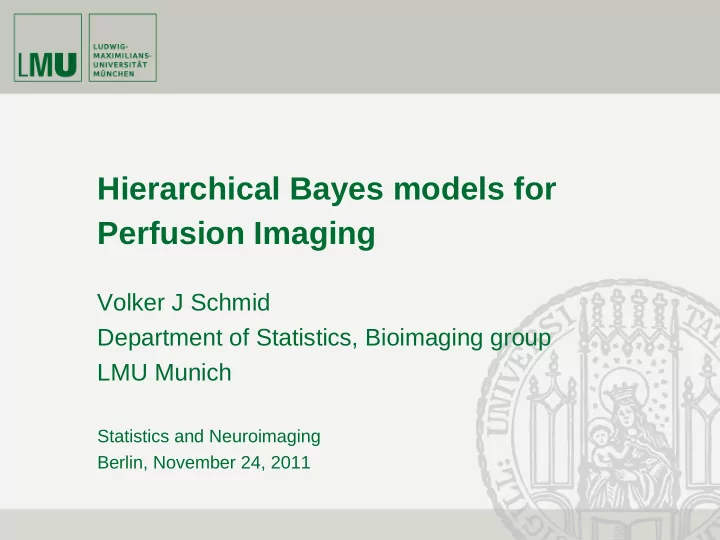

Hierarchical Bayes models for Perfusion Imaging Volker J Schmid Department of Statistics, Bioimaging group LMU Munich Statistics and Neuroimaging Berlin, November 24, 2011
Perfusion Imaging Interest in imaging blood perfusion in vivo Detection and quantification of areas with pathological high or low blood flow Applications: • Oncology (DCE-MRI) • Ischemic diseases (strokes, DSC-MRI, myocardial) • Rheumatology
Contrast-Enhanced MRI MRI allows non-invasive in-vivo imaging Imaging of magnetic properties → use magnetic contrast agent (CA) CA travels via blood stream, allows to assess perfusion into tissue E.g. in oncology (DCE-MRI): • Angiogenesis: Growth of vessels from cancerous tissue • Detection/Size measurement • Diagnostics • Evaluation of therapy
DCE-MRI - Data
DCE-MRI - data
Compartment Model for DCE-MRI k ep ∫ = ⊗ = − = ⊗ − trans C ( t ) C ( t ) f ( t ) C ( u ) f ( t u ) du C ( t ) C ( t ) K exp( k t ) t p p t p ep
Myocardial Perfusion = ⊗ S ( t ) A ( t ) f ( t ) A(t) measured in left ventricle blood pool S = Af = AB β = Dβ Jerosch-Herold et al. (IEEE TMI 2004) Response f modeled as penalized B-Spline P ∑ = β f ( t ) B β λ 2 β ~ N( , ) − pt p ip i , p 1 = p 1 Schmid (IEEE TMI 2011) 10.09.2009 # 7 Schmid: Spatio-Temporal Modelling of Cardiovascular MRI
Other local models • Linear Models → fMRI ( e.g., Brezger, Fahrmeir, Hennerfeind 2009 JRSS ) • Two-, N-compartment models • Model choice • See Kaercher, Schmid, ISBI 2010 ) • Stochastic differential equations (for FRAP) • See Dargatz, 2010
Non-linear Regression • Model for breast cancer ( ) − − a exp( m t ) exp( k t ) 2 ∑ i i ep = trans C ( t ) DK t − k m = i 1 ep i • AIF parameters D, a 1 , a 2 , m 1 , m 2 known • Least square algorithm (Levenberg-Marquardt) • Starting values? • Convergence? • Biological not realistic values ( K trans > 20 )
Bayes Approach Use Priori-Information: θ = log(K trans ) ~ N(0,1) ϕ = log(k ep ) ~ N(0,1) l(Y) p(K trans ,k ep ) p(K trans ,k ep |Y) = ∫ l(y) p(h) dh
Parameter maps estimation error(K trans ) K trans Schmid, Whitcher, Padhani, Taylor, Yang, IEEE TMI (2006), 25:12, 1627-1636
Contextual information • Although models are simplified, model fitting is typically challenging • “ Very non-linear” • Low signal-to-noise ratio • Convolution → Use contextual information to make model fitting more robust (“borrowing strength”) • Use contextual model to test dependencies
Contextual information • Spatial information, inherent in images • Adjacent voxels share same tissue, have similar properties • Voxel grid is arbitrary • But: account for edges, sharp features • Meta information • Images from same object (with or without registration) • Covariates (patient information, scanner/experiment settings) • Additional observations (e.g. EEG)
Hierarchical Modelling Level 1: Noise structure Level 2: Local model (Cinetics) Level 3: Contextual information (e.g., spatial) Level 4: Hyper parameters (e.g., smoothing parameters) • Prior information on latent, unobserved parameters • “Flat priors”
Markov random field for DCE-MRI • Assumption: Adjacent voxel have similar kinetic parameters • Markov random field on K trans and k ep ( ) ( ) ∑ ∑ trans trans log K ~ N w log K , 1 / w i ij j ij ∈ ∂ ∈ ∂ j j í í • Spatial smoothing has to account for edges and sharp features • Smoothing weights w ij are estimated locally and adaptively from the data
Results spatial DCE-MRI estimation error (K trans ) K trans Schmid, Whitcher, Padhani, Taylor, Yang, IEEE TMI (2006), 25:12, 1627-1636
Results spatial DCE-MRI Schmid, Whitcher, Padhani, Taylor, Yang, IEEE TMI (2006), 25:12, 1627-1636
Longitudinal drug studies • In longitudinal drug studies, we are interested in finding differences in the 4D images • For example, anti-angiogeneis drugs should lower K trans values • Standard procedure: • Estimate K trans • Compute average K trans per scan • Test on differences between groups • Low patient numbers • Information loss by averaging
Contextual information for Longitudinal Studies Voxels are from a scan Scans are from a patient Patient has some response to treatment and has certain properties (covariates z ) → Use mixed effect model as contextual information = α + β + γ + δ + ε trans T log( K ) z x x is s i i s is α, β fixed effects; γ, δ, ε random effects
LoMIS Longitudinal Medical Imaging Studies Observed data Local kinetic model Context (study model) Prior information
Mixed effect time curves Schmid, Whitcher, Padhani, Taylor, Yang, MRM (2009), 61, 163-174
Results LoMIS Whitcher, Schmid et al ., Magn.Res.Mat. 24:2 (2011)
Results LoMIS
Results LoMIS
Conclusions • We use contextual information to • Gain strength for local model fitting • Gain information on dependencies (allows tests) • Contextual information is defined via (flat) prior distributions • Conclusions are drawn from posterior, including uncertainty information on parameter estimates • Local models can have a variety of forms, model choice (?)
Thanks for your attention! Acknowledgements Brandon Whitcher Ludwig Fahrmeir Guang-Zhong Yang Anwar Padhani Julia Karcher Christiane Dargatz
Recommend
More recommend